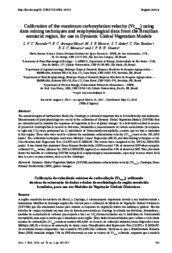Calibration of the maximum carboxylation velocity (Vcmax) using data mining techniques and ecophysiological data from the Brazilian Semiarid region, for use in Dynamic Global Vegetation Models.
Calibration of the maximum carboxylation velocity (Vcmax) using data mining techniques and ecophysiological data from the Brazilian Semiarid region, for use in Dynamic Global Vegetation Models.
Author(s): REZENDE, L. F. C.; ARENQUE-MUSA, B. C.; MOURA, M. S. B. de; AIDAR, S. de T.; RANDOW, C. V.; MENEZES, R. S. C.; OMETTO, J. P. B. H.
Summary: The semiarid region of northeastern Brazil, the Caatinga, is extremely important due to its biodiversity and endemism. Measurements of plant physiology are crucial to the calibration of Dynamic Global Vegetation Models (DGVMs) that are currently used to simulate the responses of vegetation in face of global changes. In a field work realized in an area of preserved Caatinga forest located in Petrolina, Pernambuco, measurements of carbon assimilation (in response to light and CO2) were performed on 11 individuals of Poincianella microphylla, a native species that is abundant in this region. These data were used to calibrate the maximum carboxylation velocity (Vcmax) used in the INLAND model. The calibration techniques used were Multiple Linear Regression (MLR), and data mining techniques as the Classification And Regression Tree (CART) and K-MEANS. The results were compared to the UNCALIBRATED model. It was found that simulated Gross Primary Productivity (GPP) reached 72% of observed GPP when using the calibrated Vcmax values, whereas the UNCALIBRATED approach accounted for 42% of observed GPP. Thus, this work shows the benefits of calibrating DGVMs using field ecophysiological measurements, especially in areas where field data is scarce or non-existent, such as in the Caatinga
Publication year: 2016
Types of publication: Journal article
Unit: Embrapa Semi-arid Region
Observation
Some of Embrapa's publications are published as ePub files. To read them, use or download one of the following free software options to your computer or mobile device. Android: Google Play Books; IOS: iBooks; Windows and Linux: Calibre.
Access other publications
Access the Agricultural Research Database (BDPA) to consult Embrapa's full library collection and records.
Visit Embrapa Bookstore to purchase books and other publications sold by Embrapa.

